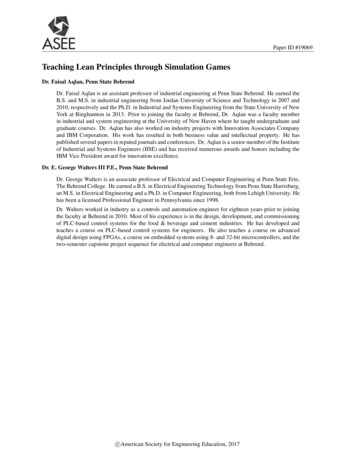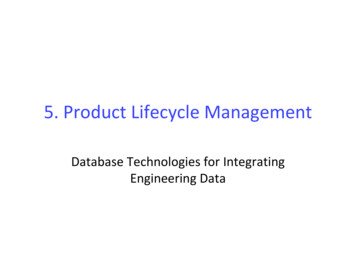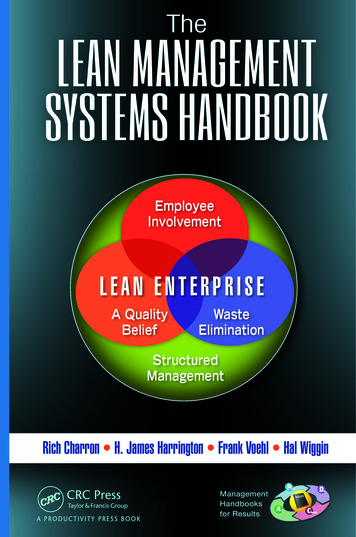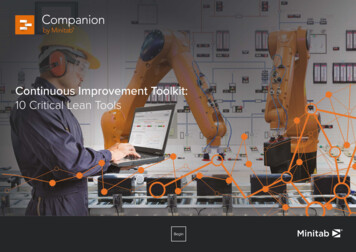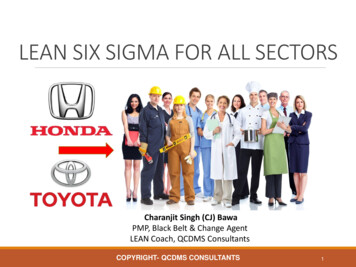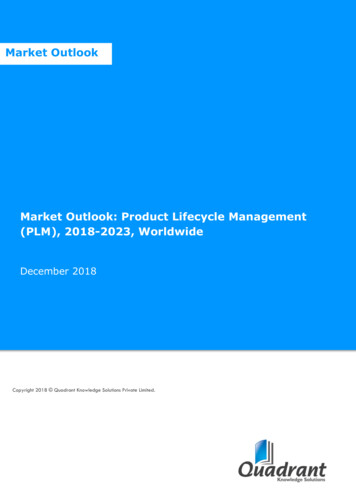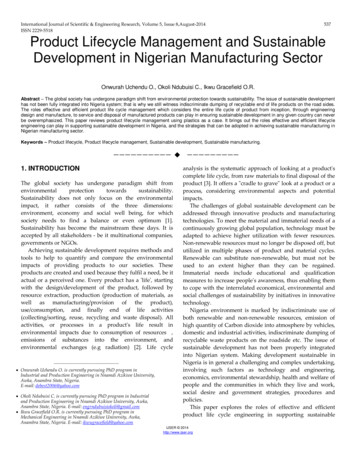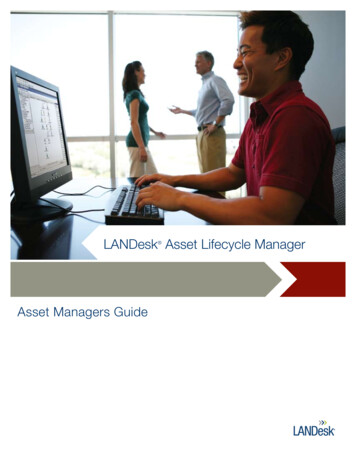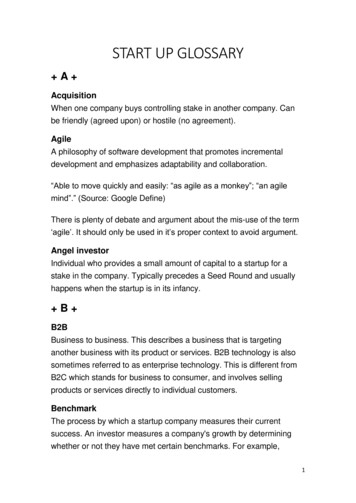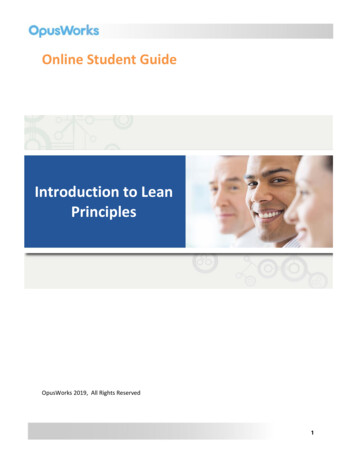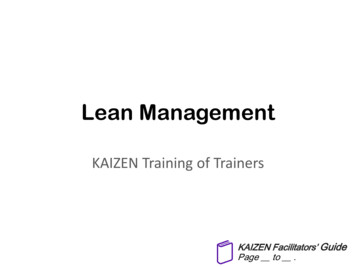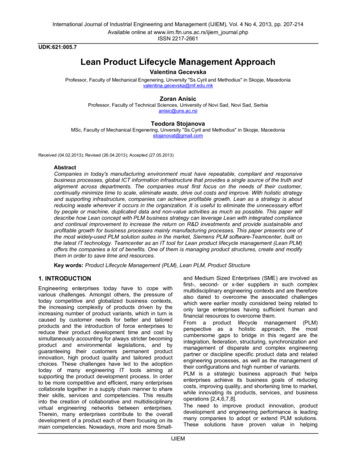
Transcription
International Journal of Industrial Engineering and Management (IJIEM), Vol. 4 No 4, 2013, pp. 207-214Available online at www.iim.ftn.uns.ac.rs/ijiem journal.phpISSN 2217-2661UDK:621:005.7Lean Product Lifecycle Management ApproachValentina GecevskaProfessor, Faculty of Mechanical Engenering, Unversity "Ss.Cyril and Methodius" in Skopje, Macedoniavalentina.gecevska@mf.edu.mkZoran AnisicProfessor, Faculty of Technical Sciences, University of Novi Sad, Novi Sad, Serbiaanisic@uns.ac.rsiTeodora StojanovaMSc, Faculty of Mechanical Engenering, Unversity "Ss.Cyril and Methodius" in Skopje, Macedoniastojanovat@gmail.comReceived (04.02.2013); Revised (26.04.2013); Accepted (27.05.2013)AbstractCompanies in today's manufacturing environment must have repeatable, compliant and responsivebusiness processes, global ICT information infrastructure that provides a single source of the truth andalignment across departments. The companies must first focus on the needs of their customer,continually minimize time to scale, eliminate waste, drive out costs and improve. With holistic strategyand supporting infrastructure, companies can achieve profitable growth. Lean as a strategy is aboutreducing waste wherever it occurs in the organization. It is useful to eliminate the unnecessary effortby people or machine, duplicated data and non-value activities as much as possible. This paper willdescribe how Lean concept with PLM business strategy can leverage Lean with integrated complianceand continual improvement to increase the return on R&D investments and provide sustainable andprofitable growth for business processes mainly manufacturing processes. This paper presents one ofthe most widely-used PLM solution suites in the market, Siemens PLM software-Teamcenter, built onthe latest IT technology. Teamcenter as an IT tool for Lean product lifecycle management (Lean PLM)offers the companies a lot of benefits. One of them is managing product structures, create and modifythem in order to save time and resources.Key words: Product Lifecycle Management (PLM), Lean PLM, Product Structure1. INTRODUCTIONEngineering enterprises today have to cope withvarious challenges. Amongst others, the pressure oftoday competitive and globalized business contexts,the increasing complexity of products driven by theincreasing number of product variants, which in turn iscaused by customer needs for better and tailoredproducts and the introduction of force enterprises toreduce their product development time and cost bysimultaneously accounting for always stricter becomingproduct and environmental legislations, and byguaranteeing their customers permanent productinnovation, high product quality and tailored productchoices. These challenges have led to the adoptiontoday of many engineering IT tools aiming atsupporting the product development process. In orderto be more competitive and efficient, many enterprisescollaborate together in a supply chain manner to sharetheir skills, services and competencies. This resultsinto the creation of collaborative and multidisciplinaryvirtual engineering networks between enterprises.Therein, many enterprises contribute to the overalldevelopment of a product each of them focusing on itsmain competencies. Nowadays, more and more Small-and Medium Sized Enterprises (SME) are involved asfirst-, second- or x-tier suppliers in such complexmultidisciplinary engineering contexts and are thereforealso dared to overcome the associated challengeswhich were earlier mostly considered being related toonly large enterprises having sufficient human andfinancial resources to overcome them.From a product lifecycle management (PLM)perspective as a holistic approach, the mostcumbersome gaps to bridge in this regard are theintegration, federation, structuring, synchronization andmanagement of disparate and complex engineeringpartner or discipline specific product data and relatedengineering processes, as well as the management oftheir configurations and high number of variants.PLM is a strategic business approach that helpsenterprises achieve its business goals of reducingcosts, improving quality, and shortening time to market,while innovating its products, services, and businessoperations [2,4,6,7,8].The need to improve product innovation, productdevelopment and engineering performance is leadingmany companies to adopt or extend PLM solutions.These solutions have proven value in helpingIJIEM
208Gecevska V. et al.manufacturers improve their product innovation,product development, and engineering performance –and ultimately the profitability of their products.To be competitive in the current world economy,companies need a PLM strategy focused on ing data.However, many companies struggle with the best wayto transform their business and take advantage ofthese enabling PLM technologies. For any technologyto provide a business benefit, it has to allow companiesto change the way they do business so that they aremore competitive, reduce business risk, increaserevenue, decrease cost, or in some other wayrecognize tangible business advantage.Key technologies to support these business modelshave changed as well from mass production, to aflexible manufacturing system, to manufacturingknowledge management, to product customization, toproduct knowledge management, and to productlifecycle management (PLM) [1,2,3,4,5,10]. As such,PLM is recognized by world’s leading universities,institutes, and solution vendors as the next big wave inenterprise application software.Lean thinking is a strategy that has already beensuccessfully implemented at several manufacturingsettings in order to produce efficiently. Any activityperformed at a factory that creates no value for thecustomer such as loss of time, extra cost, or overstockof inventory can be considered as “waste.”Consequently, lean thinking is the answer to eliminatesuch waste and achieve efficiency, quality, and safetyin production.Through the years, several different solutions havebeen proposed to achieve improvement, such asEnterprise Resource Planning (ERP), Supply ChainManagement (SCM), and Customer RelationshipPlanning (CRP). Much of these systems adopt severalinteresting strategy management techniques. PLM is arelatively new concept that concentrates on theproduct; links the best practices of industrial engineering, lean thinking and operations management.2. PLM - BUSSINES STRATEGYPLM provides customers, developers, manufacturers,and suppliers with the most effective means ofcollaboratively managing business activities throughoutproduct development. PLM supports the capability ofinnovation, creation, management, share, and use ofproduct data, information and knowledge in virtualenterprise networks by integrating people, processesand technology.As an information technology strategy, PLMestablishes a coherent data structure that enables realtime collaboration and data sharing amonggeographically distributed teams. PLM lets companiesconsolidate multiple application systems whileleveraging existing legacy investments during theiruseful lives.PLM systems manage a portfolio of products,processes, and services from its initial conception,through design, manufacture and supply, to serviceand disposal. Throughout the entire product lifecyclethere exist three major objectives, which are: customer benefit such as product quality andserviceability, company benefit such as product cost andprofit, and society benefit such as clean and greenenvironment.To reach customer benefits (customization, time-toinnovation, product quality and reliability) arerecognized as the key approaches enabled withtechnologies e.g., product family design, platformbased design, modular product design, design processmodeling and management, design knowledgemanagement, collaborative design engineering,function/ behavior/ structure design, etc.To achieve company benefits, time-to-market, time-tovolume, and time-to-profit are known as the ative product service, product lifecycle processmanagement, product lifecycle information andknowledge management, etc.To obtain society benefits, design for service, designfor reuse and design for recycle are justified as the keyapproaches enabled with technologies, e.g. product/service co-design, collaborative early design forlifecycle efficiency, environmentally design, etc.There are companies that supply software to supportthe PLM process. That software itself is just a tool andcannot make many contributions if the PLM process isnot defined first and understood by its users whom itshould contribute to at the end.Setting up PLM within the company is a process andproject itself. Implementation of the PLM concept in theenterprise enables to cost effectively deliver productenhancements, derivatives, niche offerings and addons that extend the profitable duration of the productlifecycle. PLM facilitates this objective by enabling tocreate product platforms that accelerate start upprocesses, minimize time to market cost and maximizethe revenue generated by a product’s initial release.The most important part of the PLM model isinformation. This is the engine that moves all areas(see Figure 1). Following the characteristics of aproduct’s life, the PLM model includes the followingdivisions: plan, design, build, support, and dispose.The plan division is the study and examination of thefuture product before it is introduced into the market.All the characteristics of the product itself are analyzedin this phase with special emphasis is given totechnical and engineering attributes. According to leanmanufacturing strategies, the planning of a productshould be based on customer needs and demands. Inorder to avoid any waste (extra inventory, extra cost,defects etc) it is important to anticipate demand andplan the production, in quality and quantity, accordingto what the customer wants.There are several ways in which the product can bemanufactured. In the design phase the physicalattributes such as colour, form and size of the producthave a great importance and quality standards are alsoIJIEM
209Gecevska V. et al.taken into account. Based on all attributes andrequirements, the production engineers actually buildthe units and make sure design is achievable.The building process involves all manufacturingprocedures such: factory selection, machinery,materials, and the most qualified work force. It is notuncommon to discover that an apparently good designis actually not feasible. The assembly department willinform if indeed the machinery is appropriate to make aparticular creation or if there are necessary tools, orhuman skills, to convert a sketch into a real product.The support of a product can be divided into two goals:the marketing of the product and the maintenance of it.Marketing is informing the customers about the productand how to obtain the best performance of it.Maintenance has to do with solving any technicalproblem that may arise.Finally, the last stage of the PLM model, dispose, hasto do with all possibilities of reuse, reprocessing or anypotential salvage of the product.The figure below shows the relationships betweenthese enterprise solutions. Product businesses have attheir core the intellectual assets describing theirproducts [10].of products and services through entire value streamsthat flow horizontally across technologies, assets anddepartments to customers.Eliminating waste along entire value streams, insteadof at isolated points, creates processes that need lesshuman effort, less space, less capital, and less time tomake products and services at far less costs and withmuch fewer defects, compared with traditionalbusiness systems.Companies are able to respond to changing customerdesires with high variety, high quality, low cost, andwith very fast throughput times. Also, informationmanagement becomes much simpler and moreaccurate.According to LEI (Lean Enterprise Institute), there are 5steps in the lean practice:1. Specify value from the standpoint of the endcustomer by product family.2. Identify all the steps in the value stream for eachproduct family, eliminating whenever possible thosesteps that do not create value.3. Make the value-creating steps occur in tightsequence so the product will flow smoothly toward thecustomer.4. As flow is introduced, let customers pull value fromthe next upstream activity.5. As value is specified, value streams are identified,wasted steps are removed, and flow and pull areintroduced, begin the process again and continue ituntil a state of perfection is reached in which perfectvalue is created with no waste.Fugure 2. Five steps in the lean practiceFigure 1. Relationships among Enterprise solutions [10]3. LEAN CONCEPT THROUGH PLM3.1 Lean conceptLean means creating more value for customers withfewer resources[9,10,11]. A lean organizationunderstands customer value and focuses its keyprocesses to continuously increase it. The ultimategoal is to provide perfect value to the customer througha perfect value creation process that has zero waste.To accomplish this, lean thinking changes the focus ofmanagement from optimizing separate technologies,assets, and vertical departments to optimizing the flow3.2 Lean PLM implementationLean PLM implementation is to apply the leanprinciples to a PLM implementation to ensure that allingredients in the implementation is well justified and ofvalue and there is no waste and there is minimumchange needs [11].The focus of lean PLM is to address the need of theright amount of product data in different stages ofproduct life cycle to serve the requirement of businessintelligence, based on which sound business decisionscan be made in a timely way [10]. PLM is often global,across multiple business entities, therefore, lean PLMwould also address the needs for intelligent, secureand efficient communication across board. For smalland medium local businesses, lean PLM wouldaddress PLM needs in the form of on-demandrequirements for on-demand services.IJIEM
210Gecevska V. et al.According to Aras Corp. [14], an enterprise PLMsystem that supports lean initiatives includes: Process Structure Ability to define productdevelopmentphases,milestonesanddeliverables in formats that accommodate themany complexities of the business. Visual Management Ability to see the progressand status of product programs as they movethrough product development. Knowledge Management Ability to capture,store, sort, and easily retrieve productinformation in a comprehensive context. Process Flexibility Ability to easily modifybusinessprocessesandinformationrelationships to quickly adapt to businessconditions, as opposed to the rigid nature ofERP and PDM (Product Data ion, collaboration and coordinationwithout the limitations inherent in conventionalsystems.3.3 Lean PLM collaborating aspectsFor many production and manufacturing processes,they must need to focus on the consumer or customer,retailer and distribution. Also, a core component of leanis focusing on the customer. To achieve collaboratingwith aspects of the value chain, validating constraintsand compliance early and often, continually gknowledge and intellectual property, integrating to theextended enterprise systems, engraining governanceinto processes and continually improving withoutcoding are standard PLM best practices [10,12]. ThesePLM best practices will allow the company tocontinually minimize time to scale, eliminate waste, anddrive out costs.Focusing on the customers: To drive growth andprofitability, companies need to focus on the customerand must identify their unique value propositions forcustomers and align these with their channel. Withthese characteristics, R&D costs can be lowered by notdesigning in non-value added capabilities, time can bereduced by eliminating non-value added iterations,excess material costs and carrying costs can beeliminated, product quality and consistency improved,and regulatory risks reduced. Integrating these s and providing continual validation willensure products meet customer expectations andimprove product success rates. Additionally, lead timesare reduced, waste is eliminated and costs arereduced.Collaborating with aspects of the value chain: Toimprove quality, increase innovation, reduce costs andtime, many researches concluded that increasedcollaboration is essential. Extending collaboration fromR&D (research & development) and SCM (supply chainmanagement) to suppliers and retailers will provideincreased agility, extend internal capabilities, reducetime, improve quality, lower costs and improveinnovation.As new capabilities or capacity are required, suppliercollaboration and enablement programs can reducetime and costs, improve quality and increaseinnovation. Further, many companies are increasedlevels of collaboration, both internally and across theenterprise, in an effort to increase agility and velocity.Validating constraints and compliance: As lead timesare compressed, participation of additional resourcesand product complexity increased; early identificationof potential issues and timely mitigation is critical. Theearlier a project can be stopped or realigned, the lesscapacity is wasted, the further costs are reduced. Atany stage of development, target specifications,product and project costs and projected dates can bevalidated, and regulatory restrictions by market andproduct type best-practices guidelines can be checked.In addition to these R&D-oriented validations, supplychain constraints and vendor compliance capabilitiesthat are validated late in the development process canbe proactively validated. A supplier’s capability matrixrating, social responsibility, sustainability index,enablement status, quality rating, preference status,compliance risk and readiness values can be used toidentify the best sustainable source of materials orproducts[10].Managing knowledge: This is crucial phase of product’srealization. Effective reuse of knowledge andintellectual property is keys to reducing time,eliminating waste, reducing costs and improving qualitywhile meeting customer requirements. Ready accessto relevant and accurate information can eliminate theneed to search for information in multiple systems oroffline sources. It will eliminate non-value added, trialand-error iterations and halt the initiation of dead endprojects. To achieve these benefits, information mustbe effectively captured, categorized, validated,secured, put into global content, referenced to adjacentinformation, and the relevance status maintainedthrough the lifecycle. Semantic search engines canmine the data and visual-comparison engines can helpturn data into relevant and actionable information.When information needs to be provided to theextended value chain, specifications are used tocommunicate the appropriate information and secureintellectual property.Integration to the extended enterprise system: Tomake, source, distribute and sell products, PLMinformation must be integrated into extended enterprisesystems. For most companies, the PLM systeminformation will not be different from the operationalplanning systems. Some R&D oriented or proprietaryinformation will not be integrated to the extendedenterprise systems. Items, components, formulas/recipes, routings, products, new vendors, qualityspecifications and new customers must be sent to theERP system. To ensure R&D is working with the mostcurrent information, costs, quality, sourcing, product orpilot assays and production volumes and statuschanges must be communicated back into PLM.Collaboration with vendors, customers and retailers viacollaborative workspaces or integration can shortentime, reduce costs and improve quality.IJIEM
211Gecevska V. et al.4. LEAN MANAGEMENT INTO PLM STAGES5.1 Teamcenter as a tool for Lean PLMApplying Lean initiatives in all stages of productlifecycle means bigger benefits for the companies.Every mistake detected in product lifecycle stages(product design, planning, manufacturing), costs a lot.Implementation of Lean Management in productlifecycle helps to reduce these costs in order toincrease the profitability of the company, improvingproduct innovation, or getting product to market faster.Organizations might look at these as cost reducingstrategy or time-to-market strategy [13].There are certain basic truths according to some of thePLM stages which are result of PLM and LeanManagement. The key one is that for effective productdevelopment everybody who is involved shares thesame data and information. But in organizations thatoften doesn't happen. For example, few organizationswork with a single bill of materials (BOM), but all ofthem have different systems to view a bill of materialswhich are not connected. Changes made in one ofthem are not updated in the others. Lean means not toduplicate data, because it is expensive, and canintroduce errors, additional costs and time waste.Product lifecycle management, offers a way tocollaborate, share, and exchange data in theorganization and other involved users, withoutduplicating information or redoing tasks. PLM is asystem for lean in eliminating: waste, risk of errors, andwasted time. Optimizing the time which is necessaryfor product development or product design is possible ifcompanies can have two views of the BOMs withouthaving two BOMs [13]. This is a solution for fastermanaging bill of materials.In today's high competitive market companies areworking on continuous improvement. All of them wantto have a system which can faster adapt theirprocesses to changing: market conditions, customerrequirements and supply chain structures. PLMenables the necessary collaboration for followingmarket trends.Teamcenter suite by Siemens PLM is built on the latestIT technology with a unified SOA (Service-orientedarchitecture) and all modules share a common datamodel and database [9,12]. Teamcenter includes threefoundational areas: Enterprise Knowledge leVisualization. Teamcenter also contains fourteenfunctional areas: Supplier Relationship Management; Systems Engineering and RequirementsManagement; Manufacturing Process Management; Simulation Process Management; Maintenance, Repair and Overhaul; Reporting and Analytics; Community Collaboration; Mechatronics Process Management; Engineering Process Management; BOM Management; Compliance Management; Content and Document Management; Formula, Package, and Brand Management; Portfolio Program Management.In addition the application of Siemens PLM SoftwareTeamcenter is presented. Bill of Material (BOM)Management provides the ability to create and manageproduct structures and their multiple logical constructs.These product structures include part-to-part, part-todocument, and document-to-document relationships sothat a complete bill of information (BOI) can be definedand managed throughout a product’s and itsassociated information’s lifecycles.Teamcenter allows the companies to build, view, andmanipulate the product structure in Structure Manageror to import it from an MCAD system such as NX.Using Structure Manager in the companies it is veryeasy to visualize assemblies, make visual comparison,and analyze clearances and tolerances. The main goalof the article is to present the benefits of TeamcenterStructure Manager using an example with a product(locomotive). This is a a lean soultion how companiescan save time managing product structure [9].When an item in Teamcenter is an assembly, there cansee a BOM view object icon that exists for the item anda BOM view revision object that exists for the itemrevision. Teamcenter automatically creates a BOMview revision when user initially creates the productstructure in Structure Manager.Product structure appears in an indented BOM formatsimilar to those used in many CAD systems. Byviewing the product structure, there can see whichcomponents are parts and which are assemblies.Figure 3 shows the product structure of the locomotivewith all parts of the product. Also, Structure Manageroffers adding or removing components of theassembly, but if another user is editing a single-levelassembly within the product structure, Teamcenterprevents the user making changes until the other userhas saved the changes.5. TEAMCENTER (PLM SOFTWARE)In this paper, it is described how lean approachesschould be interpreted using software based systemand lean applied into Siemens PLM software as aglobal supplier of PLM solutions used by large numberof enterproces around the world. We have usedaccademic partnership and licensed sites of SiemensPLM software at our PLM Centers at Universities inSkopje and Novi Sad. Siemens PLM provides one ofthe broadest and deepest suites of PLM offerings in theindustry today, and has continued an program ofacquisition and partnership to broaden their offeringseven further [6]. This product is set up to takeadvantage of cross-business unit sinergies, regardingincreasing the effectiveness (building the right product)and efficiency (building the product right). SiemensPLM reports that they have 63,000 customers in 62countries, and they have 6.7 million licensed seats ofPLM software of which 5 million are Teamcenter [6].IJIEM
212Gecevska V. et al.Figure 3. Product structure displayparts of the ‘trup na vozot’ will not impact thissubassembly. But, if one or more of these parts arecomponent of another assembly (that is not precise),it will use the latest version [11].Another way to save time is to use precise part of theproduct structure, not the latest revision. The preciseparts are always the green lines in StructureManager like ‘trup na vozot’ in Figure 4. This meansthat any further changes and new revisions to theFigure 4. Precise part in the product structurecompare using one of the following standard modes(Table 1):Comparing two product structures is very usefuloption for identifying changes or differences betweentwo product structures. Product structures can beTable 1. Comparing product structures in different modeLevel modeExplanationSingle level modecompares only the first level of the product structures, with an option to include find numbers in thecomparison or exclude themMulti-level modeperforms a single-level comparison at the top level of the structure, Teamcenter then makes furthercomparisons of any subassemblies that are expanded in the two product structuresLowest level modecompares only the lowest level items of the product structures, ignoring all intermediate assembliesFor example we added one more component to ourproduct, and than we compared both productstructures in multi level mode. The difference (thenew part) is in the red line on Figure 5. There cancompare two configured structures displayed inseparate Structure Manager windows. Also there is areport of the compare command [11].IJIEM
213Gecevska V. et al.Figure 5. Comparing two product structures6. CONCLUSIONPLM has evolved from an IT system for managing datato an IT system to help manage the processes whichare based on those data. PLM establishes a coherentdata structure that enables real-time collaboration anddata sharing among geographically distributed teams.Teamcenter as a Lean tool enables customers toincrease the profitability and productivity of every stagein their product lifecycle. The companies which areusing this software notice personal and teamproductivity, shorter time to market, increased productquality and minimized product and lifecycle costs. Also,they achieve continuous improvement or leanmanagement in all stages of product lifecycle.Modifying product structures with Teamcenter StructureManager enables companies to save time and minimizethe errors in all stages of product lifecycle. Also offersexchanging data without duplicate information andtasks. This is a solution that can be applied incompanies from different industries or companies whichoffer services.7. REFERENCES[1] Pol, G., Merlo, C., Legardeur, J., (2008), "Implementationof collaborative design processes into PLM systems",International Journal of PLM, Inder-science, 2008 Vol.3,No.4 , pp. 279-294.[2] Grieves, M.(2009), PLM: Driving the Next Generation ofLean Thinking, McGraw-Hill.[3] Gecevska V., Chiabert P., Anisic Z., Lombardi F., Cus F.,(2010) "Product lifecycle management through innovativeand competitive business environment", Journal ofIndustrial Engineering and Management, JIEM, Vol.3-2,2010, pp.323-336.[4] Saaksvuori A., Immonen A.(2008), Product LifecycleManagement, Springer- Verlag.[5] Bernard A., Tichkiewitch S. (2008), Design of SustainableProduct Life Cycles, Springer Verlag.[6] Stark, J. (2004),PLM: 21st century Paradigm for ProductRealisation, Springer-Verlag.[7] Rother M., Shook J.(2004),A Lean Tool Kit Method andWorkbook, Lean Enterprise Institute, USA.[8] Smith R., Hawkins B.(2005), Lean Maintenance –Reduce Costs, Improve Quality and Increase MarketShare, Elsevier.[9] CIM Data: Teamcenter “unified”: "Siemens PLMSoftware’s Next Generation" PLM Platform.[10] Gecevska V., Veza I., Cus F., Anisic Z., Stefanic N.,"Lean PLM - Information Technology Strategy forInnovative and Sustainable Business Environment",International Journal of Industrial Engineering andManagement (IJIEM), Vol.3 No 1, 2012, pp. 15-23.[11] Rudolf H., Paulisch F., Product Creation through LeanApproaches, Lean Enterprise Software and Systems,Publ. Springer, October 2010.[12] CIM Data Inc.,(2004) "Product Lifecycle Management Empowering the Future of Business".[13] Gould L. (2006) "PLM & Lean Product om/articles(acessed:30 August 2006).IJIEM
214Gecevska V. et al.Lean pristup upravljanju životnim ciklusom proizvodaValentina Gecevska, Zoran Anisic, Teodora StojanovaPrimljen (04.02.2013.); Recenziran (26.0
knowledge management, to product customization, to product knowledge management, and to product lifecycle management (PLM) [1,2,3,4,5,10]. As such, PLM is recognized by world’s leading universities, institutes, and solution vendors as the next big wave in enterprise application so
